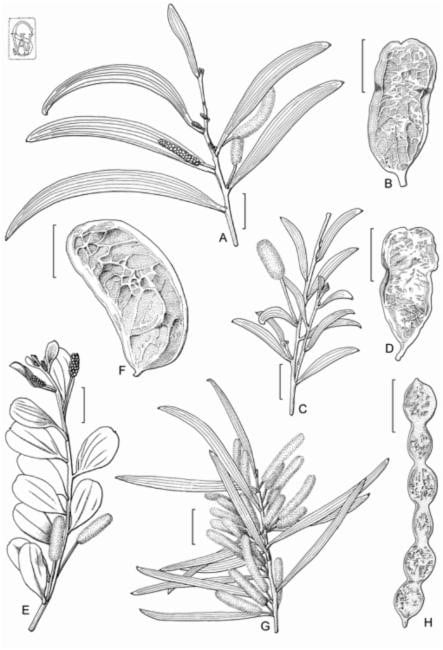Acacia minyura (typical variant)
WATTLE
Acacias of Australia
Common Name
Desert Mulga, Shrubby Desert Mulga.
Family
Fabaceae
Distribution
Ranging from the southern Pilbara and western fringe of the Gibson and Great Victoria Deserts, Western Australia, through southern Northern Territory and central South Australia to Bulgunnia Station, with three widely separated outliers in central-western Queensland.
A possible collection from Narran Lake Nature Reserve (between Brewarrina and Lighning Ridge), central-northern New South Wales (J.S. Benson & S. Waller, NSW), requires further investigation.
Description
Rounded or obconic, multi-stemmed shrubs or sometimes trees 1–4 (–5) m tall and about the same across; crowns compact and often grey or bluish grey. Branchlet ribs with a thick, normally opaque (rarely translucent) covering of resin that often persists to mature branchlets as beaded, white lines. New shoots enveloped by a conspicuous layer of resin when young, the resin opaque and whitish grey tinged bluish or translucent and brown. Phyllodes flat, straight and dimidiate to shallowly recurved or shallowly sigmoid, elliptic to oblong-elliptic or oblong-obovate, 5–25 (–30) mm long, (1.5–) 2–4 (–5) mm wide, mucronulate, grey to grey-green, sub-glaucous or glaucous, longitudinal nerves numerous and prominent. Inflorescences single in axils; peduncles 4–12 mm long; spikes 8–15 (–20) mm long. Flowers 5-merous; sepals ±free; corolla 1.4–1.5 mm long, glabrous. Pods shortly stipitate, oblong, flat, mostly 1.5–3.5 cm long, 8–15 mm wide, including wing 1–2 mm wide, chartaceous, brown, reticulately nerved, ±glabrous, dehiscent. Seeds oblique to transverse, oblong, 4.5–6 mm long, 2.5–3.5 mm wide; aril small, terminal, oblique, pileate, creamy.
Phenology
Flowers recorded March–October.
Habitat
Usually grows in sandy soils, particularly in dune swales and occasionally in shallow rocky soils.
Specimens
W.A.: N of Rawlinson Ranges, A.C. Kalotas 1621 (DNA, PERTH); 91 km S of Wiluna on road to Leinster, B.R. Maslin 7068 (AD, BRI, NSW, PERTH).
N.T.: 1.6 miles [2 km] NW of 16 Mile Bore, D.J. Nelson 1599 (DNA); old Ayers Rock road, 36.6 km E of Ranger’s Station, M. Lazarides & J. Palmer 225 (BRI, CANB).
S.A.: Bulgunnia Station, 1.7 km SW of homestead, F. Badman 6536 (AD). Qld: near Noonbah Station, Vegemont Creek, R. Dowling WP292 (BRI).
Notes
Typical A. minyura has opaque, milky blue-grey resin that envelops the vegetative buds and overtops the branchlet ribs. A less common variant with translucent, brown resin is scattered in Western Australia and probably extends to Northern Territory; see B.R. Maslin & J.E. Reid, Nuytsia 22(4): 129–267 (2012), for discussion.
Acacia minyura is a member of the ‘Acacia aneura group’ (Mulga) and appears most closely related to A. mulganeura (see this species for differences); the P.K. Latz 6873 and Winnecke collections noted by L. Pedley, Flora Australia 11B: 325 (2001), are referable to this species. Also related to A. incurvaneura which has longer, linear, shallowly incurved phyllodes.
A few specimens with atypically elongate phyllodes (not included in above description) may represent hybrids involving A. minyura as one parent, but the other parent is unknown; see B.R. Maslin & J.E. Reid (2012) for discussion.
FOA Reference
Partly based on L. Pedley, Flora of Australia 11B: 324–325 (2001).
Author
Revised version by B.R. Maslin (June 2012) and P.G. Kodela (June 2018).
This identification key and fact sheets are available as a mobile application:
URL: https://apps.lucidcentral.org/wattle/
© Copyright 2018. All rights reserved.






